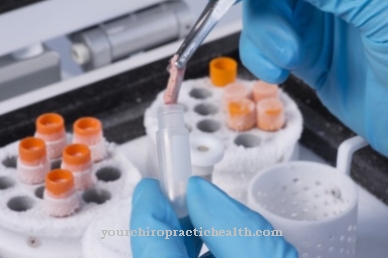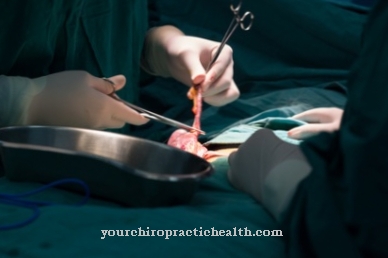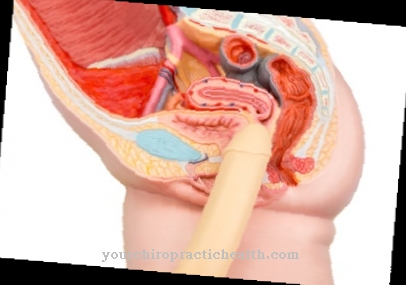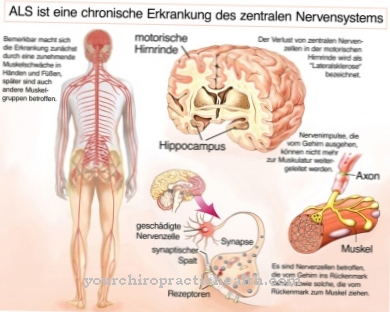In the Rectosigmoidoscopy is it a partial colonoscopy. The aim is to identify diseases in this area and, if necessary, remove polyps with a small surgical procedure. In rare cases, the procedure can injure the lower part of the intestine.
What is rectosigmoidoscopy?

Rectosigmoidoscopy is used to examine the first part of the colon, rectum, and anus. This enables diseases in this area to be identified or its course to be monitored. The rectosigmoidoscopy is also called small colonoscopy designated. In contrast to colonoscopy or large colonoscopy, where the entire colon is mirrored, with rectosigmoidoscopy only the last section of the colon (approx. 30-60 cm), the rectum and the anus are examined.
In preparation for the examination, the rectum must be emptied through two enemas. Adequate colon cleansing is also possible by taking laxatives. In contrast to colonoscopy, drugs do not have to be administered with rectosigmoidoscopy. But they are still sometimes used. Both sigmoidoscopes and colonoscopes are used during the examination.
Function, effect & goals
The small colonoscopy (sigmoidoscopy or rectosigmoidoscopy) requires the use of a flexible endoscope, the sigmoidoscope. The sigmoidoscope consists of an approx. 80 cm long tube with a light source and a small camera at the end. The intestinal wall can be examined with the help of the camera. Polyps or suspicious areas of the mucous membrane can be removed using forceps or a loop on the endoscope.
Samples are taken from these tissue parts and examined in the laboratory. Alternatively, the small colonoscopy can be obtained with a colonoscope, which is longer and is usually used for colonoscopy. In preparation for rectosigmoidoscopy, either a laxative is drunk or an enema is performed. Overall, the small mirroring only takes five minutes, and it is not necessary to take any medication. Usually, however, sleeping pills are injected into the arm vein to calm them down. Then the flexible endoscope is pushed through the anus into the lower part of the colon.
Samples are taken using special accessories. Although medication is not necessary for a small colonoscopy, sleeping pills are sometimes injected to prevent any painful sampling. A disadvantage of a small colonoscopy is often the painfulness of the examination if no medication is administered. Around two thirds of potential colon cancers grow in the area where the small colonoscopy is performed. Usually this area is also affected by polyps first. If polyps are found there, a large colonoscopy is usually recommended. However, colonoscopy is more costly and risky. Investigations into whether better screening results are achieved with colonoscopy than with rectosigmoidoscopy have yet to show in-depth study results.
So far it has been shown that even a small intestinal examination drastically reduces the risk of colon cancer by removing polyps. According to available studies that were carried out within eleven years, 5 out of 1,000 people died of colon cancer without a small colonoscopy (rectosigmoidoscopy). With rectosigmoidoscopy, only 3 to 4 in 1,000 people died of colon cancer over the same period. The large colonoscopy is performed with a colonoscope, which works like a sigmoidoscope.
However, it is 150 cm long and can view the entire large intestine. For examination, it is passed over the anus, rectum, and the entire colon until it reaches the border with the small intestine. In preparation for the examination, nothing is eaten 24 hours beforehand. A laxative with a lot of fluid then causes the bowel to empty completely. Similar to a partial colonoscopy, samples are taken and any polyps removed. To expand the intestine, carbon dioxide is introduced into the intestine in order to better reach all intestinal sections.
Risks, side effects & dangers
Unfortunately, rectosigmoidoscopy can also cause side effects and in some cases also involves risks. Without the administration of painkillers or sleeping pills, moderate to severe pain often occurs during the examination. More common side effects are temporary flatulence, which is caused by the expansion of the intestine with carbon dioxide. In addition, the laxatives that had to be consumed before the examination can lead to diarrhea days after the rectosigmoidoscopy.
In rare cases, complications can occur with small colonoscopies. Severe bleeding and intestinal perforations can occur in 4 out of 10,000 cases. The risk of complications with large colonoscopies is much greater. About 26 to 35 out of 10,000 people experience serious complications during colonoscopy. Most of these complications are bleeding from polyp removal. In very rare cases, a rupture of the bowel can occur. Another complication factor is the medication administered. This can cause allergic reactions.
Cardiovascular disorders caused by the medication are also possible. After the examination, there is always flatulence caused by the carbon dioxide gas introduced into the intestine. The medication has a calming effect, so that the patient is not fit to drive after the rectosigmoidoscopy or colonoscopy and needs someone to accompany them home. In any case, the risks of a rectosigmoidoscopy or colonoscopy are much lower than those of undetected colon cancer.



.jpg)


.jpg)





















